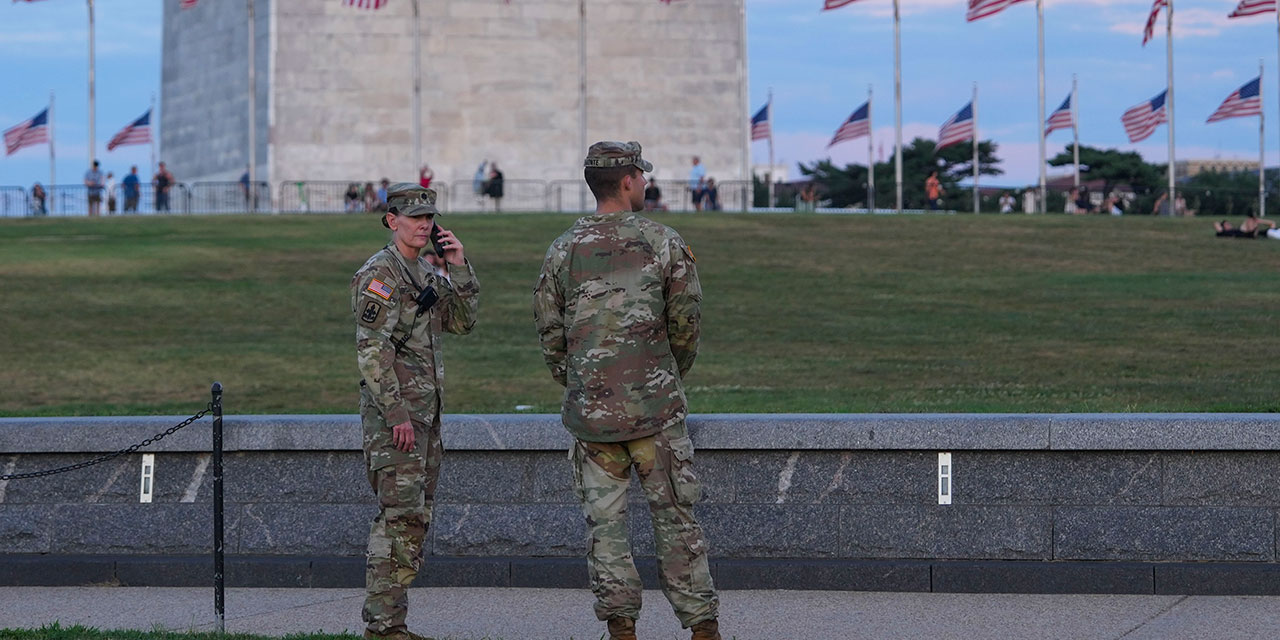
The era of defining crime deviancy down is over. That is the most important message to come out of President Trump’s deployment of the National Guard to Washington, D.C.
The late Democratic senator Daniel Patrick Moynihan of New York coined the phrase “defining deviancy down” in 1993 to describe the normalizing of antisocial behavior in contemporary America. Levels of deviancy once regarded as unacceptable become the new norm, hardly worthy of attention.
Finally, a reason to check your email.
Sign up for our free newsletter today.
Trump rejects that reflex. “I’m announcing a historic action to rescue our nation’s capital from crime, bloodshed, bedlam and squalor and worse,” he said on Monday. “This is liberation day in D.C., and we’re going to take our capital back.”
About 100 to 200 National Guard soldiers will provide administrative and logistical support for local law enforcement at any given time. They might also station themselves at intersections to deter lawlessness passively through what is known as “command presence.” Additionally, Trump temporarily installed the head of the Drug Enforcement Administration to oversee the Metropolitan Police Department.
The reaction of Democratic politicians and the mainstream media to Trump’s announcement exemplifies the defining deviancy down reflex. Virtually every news article followed its report of the National Guard deployment by noting that crime has decreased in D.C. over the last two years, as if that fact rebutted the grounds for the federal action. “We are not experiencing a crime spike,” Mayor Muriel Bowser said in objection to the president’s order. The implication: she and other D.C. officials have the situation under control. The National Guard deployment is nothing more than an authoritarian power grab, we are to believe.
Here is what such locally controlled crime looks like: on July 5, three-year-old Honesty Cheadle was sitting in a car with family members after attending a Fourth of July cookout. A drive-by shooting broke out, striking the toddler with a bullet to the upper body. She died two days later.
On May 3, 2024, three-year-old Ty’ah Settles was shot at under identical circumstances —a bullet from a drive-by shooting while Ty’ah was in a car. She died that night.
Also on May 3, 2024, a chaotic shootout among students outside Dunbar High School left a 17-year-old student inside the school with a bullet wound to the head; the victim’s skull was visible through the wound, according to charging documents.
Because the perpetrators of all these assaults were almost certainly black—only in Ty’ah Settles’s case have there been no arrests—their innocent black victims are of no interest to Black Lives Matter activists and their media cheerleaders.
On June 30, 2025, Eric Tarpinian-Jachym, a 21-year-old congressional intern and University of Massachusetts student, was struck multiple times in a multi-perpetrator shooting; he died the next day.
Media coverage of Trump’s National Guard call-out has all but ignored these incidents; they have become an unremarkable part of America’s urban fabric that now includes flash mobs, vicious and gratuitous pedestrian assaults, and mass looting. Though violent crime in Washington did decline last year from its 2023 high, the city still experienced nearly ten violent crimes a day, nearly six robberies, nearly three assaults with a dangerous weapon, and more than 14 car thefts a day, in a population of just over 700,000. In the first ten months of 2023, nearly three juveniles a day were shot. The city’s homicide rate in 2024 was 27.3 deaths per 100,000 residents.
By comparison, London’s homicide rate in 2023 was 1.3 per 100,000 residents; Switzerland’s homicide rate in 2021 was 0.48 per 100,000 residents. Anywhere else in the industrialized world, the D.C. crime situation would constitute a national emergency. It should in the United States, too.
Trump’s rhetoric undoubtedly strikes elite ears as hyperbolic and gauche. After a member of the Department of Government Efficiency was assaulted by a large group of teenagers on August 3, Trump posted that juveniles in Washington were “randomly attacking, mugging, maiming, and shooting innocent citizens, at the same time knowing that they will be almost immediately released.” One is not supposed to speak this way, yet Trump’s post describes a reality. Adolescent carjackers and robbers rack up long rap sheets while serving little to no prison time. On October 17, 2023, five girls in Washington, ages 12 to 15, assaulted a 64-year-old man with cancer who weighed about 110 pounds. The girls filmed themselves laughing as they stomped and kicked Reggie Brown to death while he lay helpless on the ground. The longest any of the five will be held is until the age of 21, but several will be out of detention long before then.
Trump’s deployment is both within his constitutional authority and a justified use of federal law enforcement power to correct what should be regarded as an intolerable situation. Nevertheless, Brian Schwalb, attorney general of the District of Columbia, called Trump’s actions “unlawful” and promised to “do what is necessary to protect the rights and safety of District residents.”
The National Guard does not threaten the rights and safety of D.C. residents; criminals do. Had city officials felt more urgency about their most fundamental obligation—safeguarding law and order—they would not be facing a temporary takeover of their public safety duties.
Whether a 30-day deployment can dent the habits of the city’s vandals and thugs remains to be seen. But many Americans likely cheered Trump’s mobilization order as “liberation” from paralyzing official passivity—and from a suffocating taboo on speaking the truth about urban crime.
Photo by Kayla Bartkowski/Getty Images
City Journal is a publication of the Manhattan Institute for Policy Research (MI), a leading free-market think tank. Are you interested in supporting the magazine? As a 501(c)(3) nonprofit, donations in support of MI and City Journal are fully tax-deductible as provided by law (EIN #13-2912529).
Source link

















